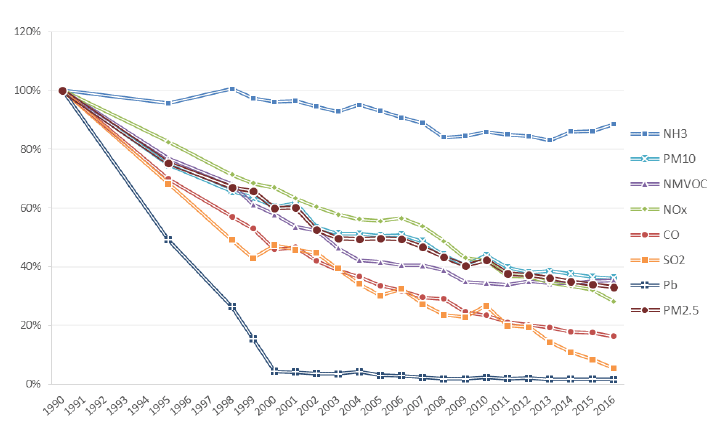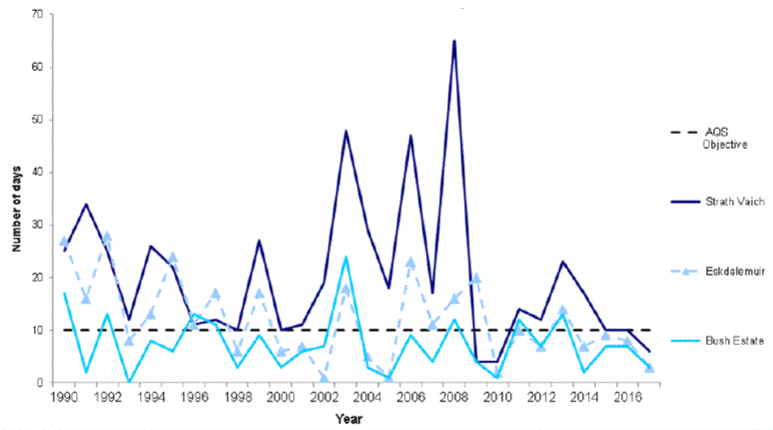Cleaner Air for Scotland strategy: independent review
Conclusions and recommendations from the independent review of the Cleaner Air for Scotland strategy.
4. Findings of the Review
4.1 The findings presented in the following sections are those of the Steering Group tasked by the Scottish Government with undertaking this review. They are based upon our own structured discussions and analyses, inputs from various interested parties, and are substantially informed by the reports of the four working groups established to support the overall review[17].
Emission trends in Scotland to 2016
4.2 Emissions of the eight main air pollutants show that levels are lower in 2016 than they were in 1990. This rate of decline is relatively similar for particulate matter (PM10 and 2.5), oxides of nitrogen (NOx), non-methane volatile organic compounds (NMVOC), sulphur dioxide (SO2) and carbon monoxide (CO). Lead (Pb) shows a much higher rate of reduction from 1990 to 2000 coinciding with the phase-out of leaded petrol from 2000 while ammonia (NH3) emissions have declined at a slower rate than other pollutants.
Figure 1: Pollutant trends in Scotland from 1990 onwards

Individual pollutant trends to 2016 (since 1990)
4.3 The following show the reductions in emissions of air pollutants in Scotland individually since 1990[18]. CAFS has been one, of many policy measures, which has helped contribute to these reductions.
- Emissions of NOx were estimated to be 90 kilotonnes (kt) in 2016 (10% of the UK total) declining by 72%.
- Emissions of SO2 were estimated to be 18kt in 2016 (10% of the UK total) declining by 94%.
- Emissions of PM10 were estimated to be 14kt in 2016 (8% of the UK total) declining by 64%.
- Emissions of PM2.5 were estimated to be 9kt in 2016 (8% of the UK total) declining by 67%.
- Emissions of NH3 were estimated to be 34kt in 2016 (12% of the UK total) declining by 12% since 1990.
- Emissions of NMVOCs were estimated to be 146kt in 2016 (18% of the UK total) declining by 65%.
- Emissions of Pb were estimated to be 3.3 tonnes in 2016 (5% of the UK total) declining by 98% since 1990.
4.4 As ground-level ozone (O3) is a secondary pollutant formed from reactions in the atmosphere (primarily from NMVOCs and NOx) source apportionment is not possible in the same way as for other pollutants and instead, trend data is produced. Due to the complexity of ground-level ozone formation and contributing factors (e.g. sunlight intensity, meteorology) O3 concentrations can fluctuate from year-to-year. The following graph shows the trends of O3 since 1990 and number of days exceeding the objective are lower for the last 10 years, likely to be due to reductions in the pre-cursor pollutants.
Figure 2: O3 trends in Scotland from 1990 onwards[19]

4.5 Air pollution is also closely linked with other environmental factors such as climate change, noise and indoor air quality and significant multiple benefits can be achieved if policy measures are integrated to ensure that maximum environmental improvement is secured while avoiding potential policy conflicts.
4.6 Reductions in emissions of air pollution have been the result of concerted action through policy measures such as CAFS, International agreements and European and domestic legislation. However, despite these improvements and generally improving trends in air quality further action continues to be required to meet existing and future legal targets on air pollution, to reduce background levels of air pollution impacting the environment and to address hotspots of poor air quality in urban centres.
4.7 Further breakdown of these data is available in a SEPA background paper[20]. Further detail on Scotland’s situation in the EU/EAA context for the main pollutants can also be found in Annex 4.
Contact
Email: andrew.taylor2@gov.scot
There is a problem
Thanks for your feedback